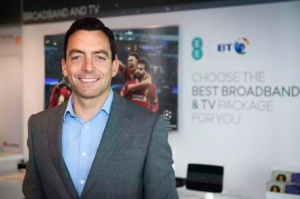
After more than 40 years of operation, DTVE is closing its doors and our website will no longer be updated daily. Thank you for all of your support.
BT and Amazon: content and convergence
BT’s announcement this week that it will integrate Amazon Prime Video into its TV offering marks a significant shift for both parties, and also illustrates a wider ongoing change in the pay TV business.

Marc Allera
Under new consumer chief Marc Allera, BT is not only opening up its platform to embrace Amazon Prime Video – something other pay TV operators have shied away from to date – but will also include Sky’s low-cost offering Now TV from next year.
The shift in video strategy follows a disappointing quarter in which BT once again lost TV subscribers, highlighting the limitations of its previous sports rights-centric approach as a tool to attract new customers.
The Now TV deal was in fact announced in December, when BT also agreed to wholesale BT Sports channels to Sky for the first time, allowing Sky to sell them direct to its satellite customers. BT
BT this year also stepped back from upping its already heavy spend on English Premier League rights, sticking with one package to Sky’s four and a reduced line-up of matches at an reduced annual expenditure.
The decision to scale back its expenditure on top-tier football and to open up its platform to Now TV and now to Amazon means that BT is positioning itself as an aggregator of content rather, with slightly less emphasis on acquiring exclusive rights.
It also reflects the view expressed by BT CEO Gavin Patterson at Mobile World Congress earlier this year when he said that BT would not go down the route followed by Telefónica and some other telecom players and invest in original drama. Patterson argued that general entertainment and movies was “a global game, increasingly”. He said that BT intended to be “a super-aggregator” in a business increasingly dominated by the likes of Netflix and Amazon.
BT is not Telefónica, which is the pay TV leader in Spain and is also an international player with a large footprint, unlike the UK telco. It therefore makes sense for geographically restricted BT, more than for most of its European peers, to tap into the global reach of an OTT TV giant such as Amazon to enhance its content offering.
BT’s broader strategy of focusing on fixed-mobile convergence and multi-play bundling rather than content as the keystone of commercial will be given a concrete reality in the form of BT Plus, a a single converged package including broadband, mobile and Wi-Fi. The telco is promoting the vision of a “single smart converged network” combining fixed and mobile assets that will deliver ubiquitous coverage wherever its customers are.
The message is clear: connectivity is the key differentiator, and focusing on this makes more sense than trying to be a media player with a comprehensive, exclusive – and expensive – content play.
And what about Amazon? The extent and direction of the e-retailer’s video ambitions is still far from clear.
The Prime Video services was the fastest-growing subscription video-on-demand service in the UK last year, according to BARB, growing by 41% to reach 4.3 million subscribers, which would indicate that BT’s decision to partner up with it is a smart move.
However, it was also reported this week by The Diffusion Group, Amazon Channels, that the streamer’s own aggregation offering, accounted for over half of all third-party direct-to-consumer subscriptions in the US, taking 53% of HBO direct-to-consumer subscriptions, 72% of Showtime’s and 70% of Starz’s D2C customers.
That represents a sizeable chunk of territory that pay TV operators would like to claim as their own. But it has to be remembered that these are specifically direct-to-consumer offerings provided on an à la carte basis rather than bundled up with other services. And HBO, Showtime and Starz still provide their content to pay TV providers as well as offering it direct to consumers in their own right.
Moreover, while the growth of Channels has raised fears of Amazon pitching itself into a head-on battle with pay TV providers, Richard Au, Amazon’s director of prime video channels and sports in the US, told the FierceCable conference in Denver, Colorado this week that the streaming giant was interested in integrating Prime Video with pay TV operators’ services. Au pointed to Comcast’s deal with Netflix as an example to follow.
Amazon Channels in the UK and Germany has in any case been a more limited proposition than the US version so far, although the inclusion of Discovery in the initial line-up rang some alarm bells. It is also less of a threat to pay TV in Europe than in the US, where the vastly higher price of pay TV subscriptions provides a clear incentive to cut the cord.
In sport – another area where Amazon has raised concern among pay TV providers – the company has so far restricted itself to testing the market, albeit with some sizeable deals, including the rights to US Open tennis in the UK and Ireland. It has not however gone the full distance by, for example, acquiring English Premier League rights, despite speculation that it would bid for a package that the EPL seemed to have tailored especially for it.
Ultimately, Amazon could still emerge as a threat to pay TV. But for now it seems, it is more interested in using video as a way to push consumers into Prime subscriptions. Amazon makes its money from e-commerce.
Telcos, on the other hand, make their money from connectivity. They are interested in using video as a way to give consumers an extra push towards fixed and mobile broadband bundles.
The distinction is clear enough for the telcos and Amazon to find an area of mutual interest.


